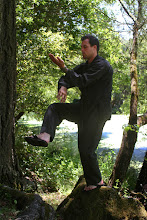Light is usually underrated as a factor in human health. Modern discoveries in chronobiology
are revealing the power of light in health, disease, psychology and
happiness. As it turns out, light acts as a master force, tuning and synchronizing every process in the human body. Unnatural light sources scramble our physiological rhythms and wreak all sorts of downstream havoc with our health and fitness. This is amazing stuff!! This "master force" that is continually fine tuning our physical organism is known as the circadian, day-night rhythm. All animals, including humans, are intimately connected to this cyclic pattern. All organisms on earth are driven by circadian cycles.
It turns out there is actually a functioning part of the brain which comes equipped with a circadian pulse generator called the suprachaismatic nucleus (SCN). This bit of tissue consists of a mere 20,000 neurons that keeps a circadian beat, roughly timed to 24 hours. This is totally cool in itself, but even more fascinating is the fact that this endogenous pulse generator is only a blunt timing instrument that approximates the earth’s circadian rhythm. To manage physiology effectively, it needs to be fine tuned (entrained) by actual environmental conditions, specifically by exposure to direct, natural sunlight.
Our modern world provides weak, ineffective cues to day-night cycles. From the modern body’s point of view, it is almost as if dawn and dusk are constantly shifting in random patterns. It is no wonder that we’re confused. We are not being refreshed by the master system. We stay up late into the night and/or get up before dawn. We watch television and live in front of computers. And even when we are awake during the day, we expose ourselves to artificial lights that are simply too weak to entrain our biological clocks. Clearly, the light coming off a computer screen is no substitute for the sun. It’s no surprise that our rhythms tend to drift. Ultimately, the result is physiological mischief. There is no telling how many physical afflictions stem, directly or indirectly, from poorly synchronized physiology.
As a body professional, I was taught that homeostasis is the body’s prime directive, but that is only half the story. The body drives towards a stable homeostatic state, but it also seeks oscillation and synchronization with the environment. Thus, my physiology is different at sunrise than it is at noon. And of course, it will be different tomorrow than it was today. I am constantly rearranging my tissue in waves of anabolic and catabolic activity. What this clearly indicates is that the timing to my food consumption and exercise is just as important as "what" foods I consume, and frequency and duration of my exercise.
Unfortunately we have not yet tapped into the power the circadian cycles offer. Very few physicians tell their patients when to take medications for example, and scarcely any trainers are scheduling their sessions to match up with circadian realities. And in the world of big fitness, modern health clubs show blatant disregard for light, dark or time of day. With constant levels of illumination in 24 hour facilities, every hour is the same as every other hour. To me this is a reflection of the mentality and underlined motive of most companies and individuals in the health and fitness industries. $$$PROFIT$$$, and that's it.
For now we can work with what we know. Here are some tips to help you take advantage your new found knowledge.For the moment, we can build on a few key findings. For example, we know that tissue repair peaks between midnight and 4:00am. (“Go to bed!”) We know that concentration, logical reasoning and alertness are at their lowest between 4:00am and 6:00am. (“Take your time waking up.”) We know that heart efficiency, muscle strength and flexibility are all highest between 4:00pm and 8:00pm. (“Try for your personal best in the late afternoon.”) With experience, we will ultimately be able to tune our activity to match up with these circadian realities.
And #1 on the list, if the sun is shining, get your butt outside!!!
Be Well,
Abijah, Fat Free Buddha, Offering Outdoor group fitness classes. call for consultation and first class free. 408-469-6764
